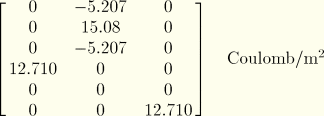
Product: ABAQUS/Standard
The static analysis capability for materials that include piezoelectric coupling is discussed and illustrated. Both mechanical loads and electrical surface charges are applied. In Mercer, Reddy, and Eve (1987) a problem subjected to a sinusoidal load is analyzed. The model definition from that problem is used to illustrate the static response due to a constantly applied load. In the following sections the applicable linear dynamics capabilities are discussed.
A cylinder of piezoelectric ceramic is subjected to both a pressure load and a distributed charge load. The cylinder is 20 mm thick with an inner radius of 5 mm and an outer radius of 25 mm. The cylinder is subjected in the first step to a pressure load on the top surface. The second step applies a distributed electrical charge on the top surface. Both the top and bottom surfaces have electrodes. The potentials on the bottom surface are prescribed to zero. The electrodes are generated by using equations that set all the potentials to the same value.
The cylinder is modeled as an axisymmetric problem using only one CAX4E element. The material properties for the PZT4 material are given as
Elasticity matrix:

Piezoelectric coupling matrix (stress coefficients):

Dielectric matrix:

The material is poled in the 2-direction.
In the first step the ![]() value should be equal and opposite to the applied vertical pressure. It is correctly computed as –1.0 × 106. The stresses in the other directions are negligible. The stress is computed as
value should be equal and opposite to the applied vertical pressure. It is correctly computed as –1.0 × 106. The stresses in the other directions are negligible. The stress is computed as
![]()
![]()
![]()
In the second step instead of the pressure load, a distributed electrical charge is applied to the top surface of the model. The ![]() value should be equal and opposite to the charge density applied to the top surface. It is correctly computed as –1.0 × 10–3. The flux density in the other direction is negligible. The flux densities are computed as
value should be equal and opposite to the charge density applied to the top surface. It is correctly computed as –1.0 × 10–3. The flux density in the other direction is negligible. The flux densities are computed as
![]()
![]()
![]()